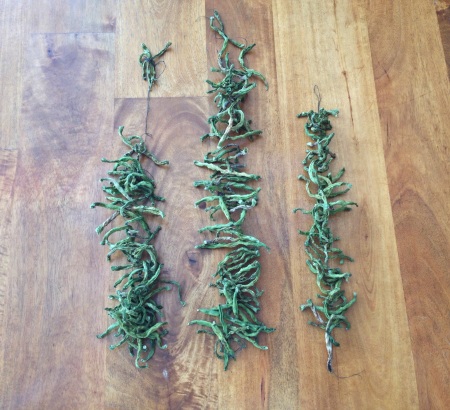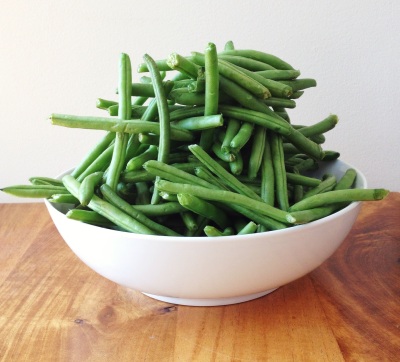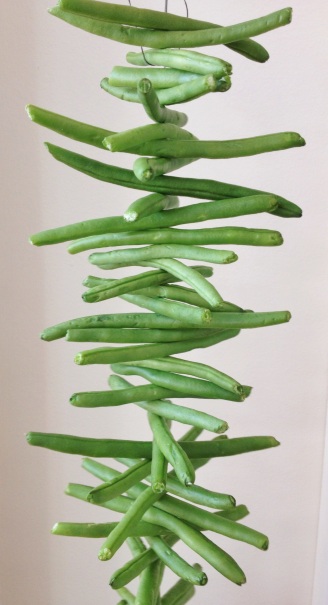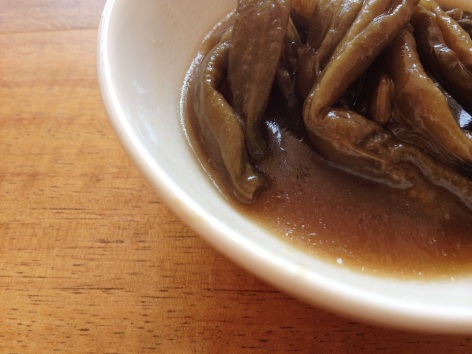History is rich with the food of the poor. The recipes that arose out of exigency are pragmatic, judicious and, very often, deeply delicious. Nothing satisfies me more than taking the most simple and inexpensive foods and coaxing unexpected flavor from them.
It is with this is mind that you can only imagine my excitement upon learning about Leather Britches, a magical and transformative method of preserving and then reconstituting beans:
“To make leather britches, you string pole beans—like a greasy bean or a turkey craw—with a needle and thread … The drying of the beans develops so much umami, it’s mind blowing … The potlikker that comes off these beans tastes like roast beef!” – Sean Brock
The first half of season 2 of PBS’ stellar series, Mind of A Chef, focuses on Chef Sean Brock as he guides viewers through some powerfully deliciousness food memories from his childhood in Appalachia. Chef Brock, along with Glenn Roberts from Anson Mills, are almost single handedly responsible for reviving near extinct varieties of grains, rice and beans. He is someone I deeply respect. So when he says something is delicious, I believe him. And so I set out to transform my humble green beans into umami bombs of faux-beefiness.
I went searching for a scientific explanation that would account for the creation of flavors that result from this drying process. But, I came up short. I found nothing. Most beans that we eat are first dried. And they are delicious, but they taste….like beans. Why does drying green beans this way yield such a deep, rich flavor? That is a good question. And I don’t have an answer.
I had successfully strung my beans and they’d dried evenly and thoroughly, but halfway through cooking them, I thought I’d made a terrible mistake. Frankly, they didn’t taste like much. I did my best to couch my disappointment and soldier on, and I am glad I did. As Sean Brock said, the flavor magic is in the potlikker, the reduced cooking liquid left in the bottom of the pot. Once I had cooked down the liquid far enough and mixed the beans back in, the magic of the Leather Britches revealed themselves to me. God’s honest truth: one of the best things I’ve ever eaten.
LEATHER BRITCHES
note: I read lots of descriptions about how to cook these beans, and like all good recipes handed down from grandma, there lacked a certain specificity. The suggested cooking times ranged from “hours” to “forever”. Take that to mean what you will- degree of doneness is a matter of taste. I cooked my beans for about an hour and 15 minutes, then removed them from the pot while I reduced down my potlikker.
yield: 2 lbs fresh beans serves 4 as a side dish
special equipment: darning needle, kite string
ingredients:
2 lbs beans (string beans, wax beans, etc)
water, about 2 cups
1/4 tsp lard (optional)
salt to taste
technique:
1.Clean- Rinse beans and remove stem end
2.String Beans– take a darning needle and thread it with string. Pierce the first bean through the middle and tie it off securely. String up the remaining beans, sticking the needle through the middle of each bean. (Once my string of beans was about an arm’s length long, I started another string. I had three strings, in total).
3.Dry beans– hang your beans to dry. Apparently, back porches are a favorite leather britches drying spot. A less charming, but equally good spot, would be tying them to your kitchen cabinets (which is what I did). Leave your beans until they are fully void of all moisture. This should take at least a few weeks. It will vary depending on air circulation and light, etc. Mine took about 2 1/2 weeks to fully dry out.
4.Cook beans- put beans in pot and add in enough water to just cover beans. Bring to boil then lower hit to simmer and cook about 1 hour. Remove beans from liquid and set aside. Add in lard (if using) and cook down liquid, aka potlikker, until you have about 3/4 cup. Add beans back in, toss with potlikker and salt to taste.
The Taste- It is hard to say enough about the transformation that occurs and how so much flavor can be developed from this drying process. The flavor is so rich and deep and satisfying.
The Process- So, you need a bit of patience here. For most of us, gone are the days when this kind of preservation method was necessary not to starve come Winter. I do not sew, and I am not especially coordinated, but once I got a rhythm going with the stringing of the beans it was relatively quick and easy.
The Verdict– Worth every bit of time and the occasional needle prick…



What a cool idea! I’ll have to try this.
Love this!!! Must try!
Your picture of the beans shows they are still not dry. Do not think weeks, think a couple of months and when beans are Brown. That’s the way they were done here in tennessee. Also you need to boil briefly and then change the water and then cook.
Your picture of the beans shows they are still not dry. Do not think weeks, think a couple of months and when beans are Brown. That’s the way they were done here in tennessee. Also you need to boil briefly and then change the water and then cook.
Hi, Jim! I found lots of different variations about how long to dry the beans/how long to cook the beans, etc. I bet that if I dried the beans for months until they were brown, like you suggested, that the flavor would be extra deep and rich. Thanks so much for the feedback. What part of Tennessee are you in? I’m always curious about regional preferences…
Mom n Gramma would dry them on Screens in the sun. They would put another screen on top n flip them. Not as easy as it sounds. When it looked like rain the would bring inside . Pain in fanny. Dry until brown (these been were snapped not whole)… they were very dry n crispie.
soak overnight.
Pour off water.
Cook w some kind of pork fat for hours, and salt. Delish !
a special occasion dish. Haven’t had in years,since they passed.
People in NC mountains stored them up for winter. MEMORIES!!!
foxfire books have great detail on this
Sounds good. I remember my mom cooking up fresh beans with a bit of salt pork and onions and I loved that. My son is vegan however so maybe this will be a good way to try them for lots of flavor and no salt pork or bacon. I wish I could grow my own beans but my tiny city, semi-arid, hot yard won’t support them (too much shade too). Well, maybe I can find some decent ones to buy so I can try this.
Do you remove the strings before you hang them? This sounds great!
Pingback: How to Dehydrate Food for Emergencies | Urban Survival Site
Gone is the time of women and children sitting around together and snapping beans and stringing them. This was a time of story telling and sharing thoughts and memories too.I still fondly have my own memories!
I live in Ireland, we just don’t have this kind of drying weather. What do you think about d dying in the dehydrator?
Can’t you just leave the beans on the plants until they dry naturally in the autumn? That’s what we do here to dry our beans – then pick them in a dry spell when they’re dry and crispy … it would certainly reduce the chances of pricking yourself on the needle!
Once dry can you put them in a poke to store my mom fixed them from time to time but can’t remember how she stored them
A pot of green beans (especially if seasoned with smoked pork and onion-then potatoes added at the end) are already one of my favorite foods! I can’t wait to try leather britches! I have heard family talk of them when I was young, but no one ever made them when I was around.
Can hardly wait to try Leather Britches with our fall beans! Porch snappin’ beans with my 91 yr old Mom is a blessing my family enjoys! Thanks for this.
I live in western NC and have some string beans in my garden that have not been picked in time. My Eastern N.C. Aunt just told me about Leather Britches! Can’t wait to try this with my over-grown string beans in the garden. She said my grandmother use to do this. Thanks for the recipe and the ‘notes’ to go along with it. Those little tid-bits of information are always helpful in adjusting and understanding these old time-worn recipes. I will have this recipe stashed along side my grandmother’s ‘Chocolate Gravy & biscuits’ recipe! : )
We called them shuck beans. Always at Thanksgiving and Christmas! But we had them all year. My grandparents had a huge garden that produced more than enough beans for them, their 2 kids, and their 4 grandkids, with bushels and bushels left over to give away, can, or dry. My brother and I spent many a weekend and more than one summer vacation picking beans in that garden, and then sitting on the porch stringing and snapping and threading beans. Hated it then – would give anything now to spend a week picking and snapping with my grandma and mom and whatever neighbor ladies dropped by while we were working.
My mom would season the beans with salt pork or a ham hock. She soaked the beans overnight and then cooked them for 3 to 4 hours. The smell of the beans and the ham hock was enough to drive a hungry child crazy.
Shuck beans were always served with cornbread. (For my 8″ skillet, the recipe is approximately this: Preheat oven to 425. Grease your cast iron skillet with bacon grease {best} or vegetable oil then place in oven for at least 10 minutes. Mix 1/4 to 1/2 cup self-rising flour with 1.5 cups of corn meal. Stir in buttermilk with a fork. You don’t want it thin and runny but you don’t want it thick and heavy. It takes practice to get the right consistency. Take cast iron pan out of oven, pour in batter, and put it back in the oven. Keep an eye on it – the top should be crusty and brown but the middle shouldn’t be wet. Takes about 20-ism minutes. Please note: there are NO eggs and NO sugar in cornbread!)
Mom sometimes stored hers in a pillowcase in the basement, but later on she stored hem in plastic containers in the freezer. And yes, we dried ours until they were brown (east Tennessee, Campbell County, where I-75 crosses the state line from Kentucky).
Seriously good eating.